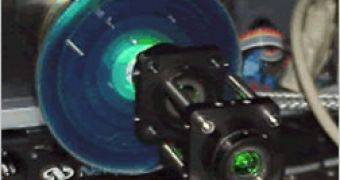Call/Recall, a San Diego optical media manufacturer has announced the world's first optical disc to hold 1TB of data. The company claims that the disc has already been tested and is entering into product design negotiations with manufacturing partners.
The disc technology is based around the former patent owned by the company, namely 2-Photon-3D, that uses a special, "near-field" lens and fluorescent media technology to record hundreds of layers three-dimensionally. The company also claims that the near-field lens can take full advantage of the standard 120 millimeter medium surface that surpass even the holographic recording technologies.
The 2-Photon-3D technology would allow a classic surface store the content of about 40 Blu-Ray DVDs (or 200 DVDs), but, in order to enter mass production, it should be easy to implement into the already existing infrastructure of the optical media manufacturers.
This approach allows optical hardware manufacturers to extend the roadmap of their existing technologies, namely DVD and Blu-ray Disc, but at the same time maintain backward compatibility with their actual production lines. Another key aspect would be the molded/replicated parts, enabling very low-cost production on industry-standard production lines.
"Businesses and enterprises must store and manage vast amounts of data for extended periods of time to ensure regulatory compliance," said Wayne Yamamoto, President, Call/Recall. "Call/Recall's optical disk solution is a perfect fit for enterprises that need a cost effective archiving solution to store and retrieve data while reducing costly IT real estate associated with large tape libraries."
The versatile 2-photon 3D technology can be applied to storage solutions like as a 100+ terabyte optical library using DVD-size disk for enterprise data storage, while the consumer electronic market would deliver a 1-inch diameter 50 GB disk, extremely suitable for cell phones, portable media players, and game systems.

 14 DAY TRIAL //
14 DAY TRIAL //